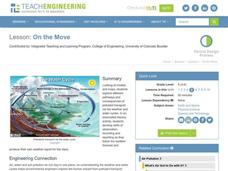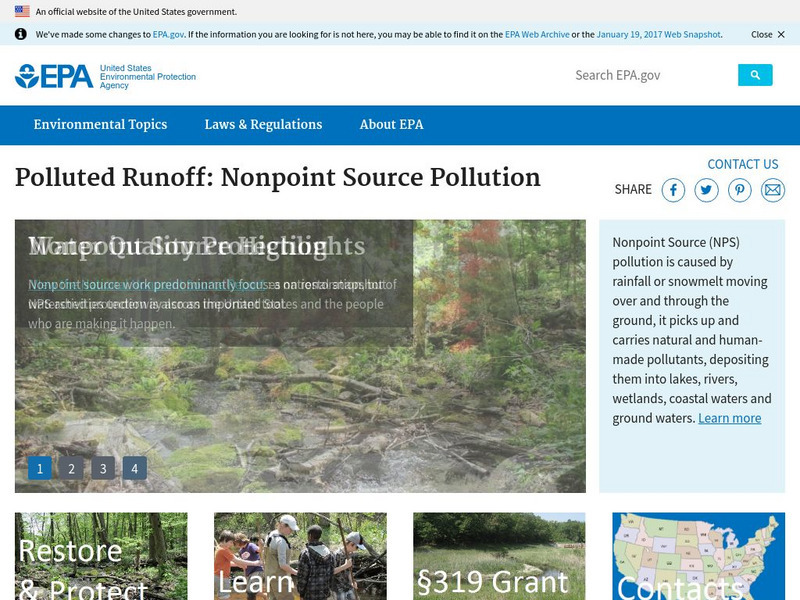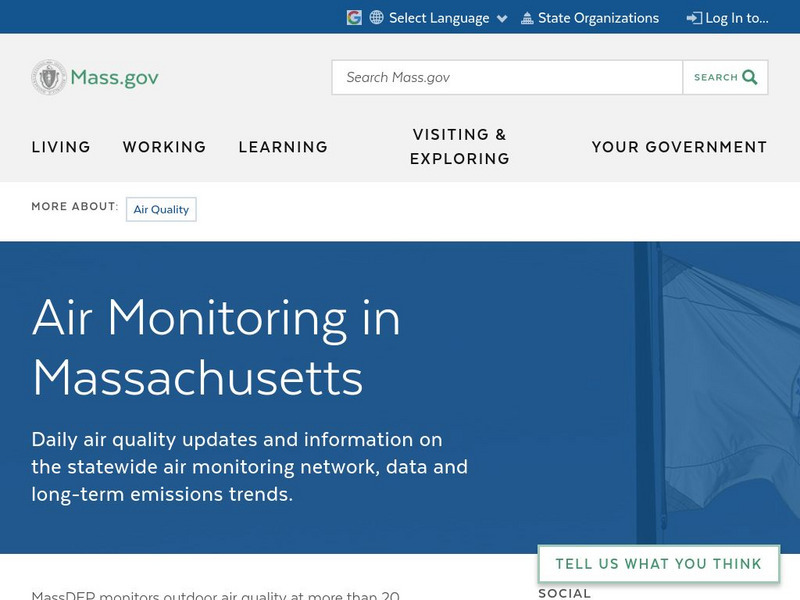Curated OER
Super Stream Keeper's
Young scholars are introduced to Delaware's waterways as precious resources used for drinking water, water for agricultural and industrial uses, recreational areas, and as habitats for wildlife. They are introduced to wastewater...
Curated OER
Water Contamination Mapping Lab
Students are introduced briefly to the Biscayne Bay Ecosystem, observed microbe distributions and water current maps are introduced. They measure water current speeds to predict the movement of pollutants based on the type of the tidal...
Curated OER
Aquatic Habitat Water Quality Experiment
Fifth graders discuss the importance of water quality for humans and fish and make predictions about what happens to water that is polluted. In small groups, they conduct experiments to compare and contrast water that is unpolluted and...
Curated OER
On the Move
Students explore different pathways and consequences of pollutant transport via the weather and water cycles. They observe and record weather information and produce their own weather report for the class.
Curated OER
Air Quality: Everyone's Responsibility
Middle schoolers identify and interpret the causes of air pollution in their local community. They collect and analyze data to identify pollutants in the air and seek solutions to eliminate the contaminants in the atmosphere. Finally,...
Curated OER
Save Our Soil
Learners gain an understanding of the small amount of soil available to sustain humans on earth and complete an appropriate graph or chart from their collected data. They locate some of the countries they have heard about where people do...
Curated OER
A Tale of Two Reactors
Tenth graders role-play as members of the food chain. Sticky tables acting as polluting factors are introduced and members of different trophic levels suffer varying degrees of damage due to those pollutants.
US Environmental Protection Agency
Epa: Envirofacts Data Warehouse
Using zip codes, this site allows students to locate businesses in their communities that are producing wastes.
US Geological Survey
Usgs: National Water Quality Assessment Program
Use this website to find out about water quality issues anywhere in the U.S.A. where water studies have been conducted by the U.S. Geological Survey.
US Geological Survey
Usgs: Water Science for Schools Effects of Urbanization
This U.S. Geological Survey website offers a short article then lists topics that are linked to brief articles that describe that particular topic's effect on water quality in urban areas. Click Home to access the site in Spanish.
Georgia Department of Education
Ga Virtual Learning: Ap Environmental Science: Air Pollution and Climate Change
Through this interactive module, students learn that the atmosphere is so much more than air, its complex role on Earth should be explored, and its quality carefully monitored and protected.
TeachEngineering
Teach Engineering: What's Hiding in the Air?
Students develop an understanding of the effects of invisible air pollutants with a rubber band and hanger air test and a bean plant experiment. They also learn about methods of reducing invisible air pollutants.
TeachEngineering
Teach Engineering: Air Pollution
Students are introduced to the concept of air quality by investigating the composition, properties, atmospheric layers and everyday importance of air. They explore the sources and effects of visible and invisible air pollution. By...
US Environmental Protection Agency
Epa: Polluted Runoff: Nonpoint Source (Nps) Pollution
EPA site offers answers to what nonpoint source pollution is as well as provides links and information as to what concerned citizens can do about it.
NASA
Nasa Earth Observatory: Natural Hazards: Dust, Smoke, and Haze
NASA's Earth Observatory offers photographs of dust, smoke, and haze throughout the world. Learn how these pollutants can be hazardous to our Earth.
Other
Eea: Air Monitoring
Find the current air quality in Massachusettes, and learn more about air pollution, air quality forecast, and governmental guidelines on air.
NASA
Nasa Earth Observatory: Global Maps: Aerosol Optical Depth
View Earth's aerosol optical depth by watching a global map evolve from January 2005 to November 2008. Learn about aerosol amounts such as volcanic ash, sea salt, smoke, and other pollutants.
eSchool Today
E School Today: Your Cool Facts and Tips on Air Pollution
Causes, effects, and prevention are some of the aspects of air pollution provided by eSchool Today. Get the facts!
US Environmental Protection Agency
Epa: Secret of Bog Creek
This site has a user guided story about a bog that has been a secret dumping ground for waste.
Cynthia J. O'Hora
Mrs. O's House: Lead Pb Environmental and Health Issues
After looking over several articles and reports about lead in the environment being toxic, students will write persuasive letters to various government officials to tell them how they feel about what the government is currently doing...
Other
Rockefeller University: The Environment Since 1970
High level discussion of environmental change in a twenty year period. Look for CFC's as you scroll down to the heading "Indicators of the environment."
Other
Water Pollution
Read about the different types of water pollution and the harm it can cause. Learn about oil spills how they are cleaned up, and how you can help prevent water pollution. Additional links point to other topics relevant to the study of...
Other
How to smile.org: Store Water Runoff Pollution
A demonstration that shows students how water systems are connected and the concept of non-point source pollution. Also it allows students to see how pollution on their playground could affect larger water supplies.
US Geological Survey
Usgs: Water Science for Schools Pesticides Ground Water
This US Geological Survey site briefly discusses the basics of why pesticides are increasingly found in our ground water. Click Home to access the site in Spanish.























